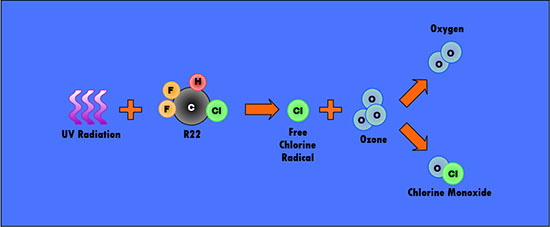Does this situation sound familiar: For the past few years you've been having your air conditioner serviced and once a year when the AC comes out he always informs you that your system has freon leak and the component that's leaking can either be replaced or you can fill the system back up with freon. You've gotten used to the whole deal and every year you have always decided to fill the system back up with freon since replacing the leaking component costs a heck of a lot more than filling the unit back up with freon, except this year he explains to you that the price of filling your unit up with freon is going to be more than double what it was last year, yikes! How can this be? Is he pulling your strings? If you feel like your getting ripped off you're not alone, but believe it or not there is a reason for this sudden increase in the price of R22 freon and it has to do with supply, demand, and the Environmental Protection Agency's decision to phase out R22.

So why has the price changed so much from last year? The reason is that this is one of the last years for R22 to be produced in the United States as production of R22 is to cease by 2020 and only available after 2020-2030 through refrigerant recovery and recycling centers for very specific applications. How come? Well, this all started around 30 years ago in 1987 when several nations came together and signed a document titled "The Montreal Protocol". This agreement which was formed by several environmentally concerned nations (more than 190 nations, including the United states) was a declaration to slowly phase out the use of harmful ozone depleting man-made products like HCFCs (Hydrochlorofluorocarbons) with R22 being one of those HCFCs on the top of the list. Why? It turns out R22 is actually pretty harmful to the Earth - R22 is a refrigerant so it evaporates at really low temperatures and as a gas it begins to float up and mix in the air, the harmful HCFC slowly makes its way up into the Earth's atmosphere and into the stratosphere where literally rips the Earth's protective layer of ozone apart, which harms the environment (hints why the Environmental Protection Agency wants it gone). HCFCs like R22 harm the planet by destroying ozone up in the stratosphere which allows the suns harmful UV light to penetrate down to the surface as well as increase ozone concentration around the surface, both of which are not a good thing for life on Earth.
So why has the price changed so much from last year? The reason is that this is one of the last years for R22 to be produced in the United States as production of R22 is to cease by 2020 and only available after 2020-2030 through refrigerant recovery and recycling centers for very specific applications. How come? Well, this all started around 30 years ago in 1987 when several nations came together and signed a document titled "The Montreal Protocol". This agreement which was formed by several environmentally concerned nations (more than 190 nations, including the United states) was a declaration to slowly phase out the use of harmful ozone depleting man-made products like HCFCs (Hydrochlorofluorocarbons) with R22 being one of those HCFCs on the top of the list. Why? It turns out R22 is actually pretty harmful to the Earth - R22 is a refrigerant so it evaporates at really low temperatures and as a gas it begins to float up and mix in the air, the harmful HCFC slowly makes its way up into the Earth's atmosphere and into the stratosphere where literally rips the Earth's protective layer of ozone apart, which harms the environment (hints why the Environmental Protection Agency wants it gone). HCFCs like R22 harm the planet by destroying ozone up in the stratosphere which allows the suns harmful UV light to penetrate down to the surface as well as increase ozone concentration around the surface, both of which are not a good thing for life on Earth.
R22 was so popular and leaking all over the world from air conditioning systems, that it actually caused nations to come together and agree to stop using it, along with other CFCs (chlorofluorocarbons) and HCFCs (hydro chlorofluorocarbons), which is why the Montreal Protocol was established. This year you can't even buy air conditioning equipment that uses R22 to cool down your home or office, and the production of R22 refrigerant has been reduced by 90% which has drastically raised its prices. What used to cost the AC man 200 dollars for a jug of R22 at the refrigerant supply store now costs over 1200 dollars, and the price unfortunately gets reflected onto the consumer making it a very expensive process to fill up an R22 air conditioner. As of now our prices at Adams Air are $100.00 a pound, which isn't bad considering most companies charge around $200 a pound, but even at these high prices it can be a huge expense to fill an air conditioner back up with 12lbs of R22 freon when it's only going to leak out again. This year the news is especially bad for people with air conditioners that use R22 because they can't replace their piece of leaking R22 AC equipment (because R22 equipment is no longer in production) which forces people in this situation to either buy the expensive R22 refrigerant or upgrade the entire air conditioning system to a different refrigerant, ouch!
Air conditioning companies have been saying this for years though, the Montreal Protocol was no secret, and you may of heard about it before (possibly from an air conditioning contractor). My father who used to own his own air conditioning service company and taught me air conditioning at a young age used to tell his customers years and years ago this was eventually going to happen. Since the ban date was so far away and production enforcements didn't yet exist most people were left speculating if the ban ever really was going to happen and they decided to stick it out and fill their systems up with R22 freon and just wait and see if the Montreal Protocol ever began to be enforced. Well as the deadline is growing closer, the United States and the HVAC equipment and refrigerant manufacturers are finally conforming to the Montreal Protocol by reducing production by 90% and 95% by 2020. The USA is actually one of the last countries to still use the stuff as all of Europe has already been converted. Unfortunately if this is one of those years where you may be down on your luck and can't afford the R22 freon or the new HVAC system the AC man quotes you, you could find yourself stuck between a rock and a hot place, and in Houston that's now where you want to be!
What really happens between R22 and the ozone in the stratosphere?
For all you science fanatics out there, in order to first understand why the ozone layer gets depleted by HCFCs like R22 we need to first look at the atoms that make up Hydrochloroclourocarbons like R22 and the atoms that make up Ozone. Ozone consists of 3 oxygen atoms whereas HydroChloroFlouroCarbons like R22 are very stable molecules that consist of atoms of hydrogen, chlorine, fluorine, and carbon. The high stability of these compounds allows them to persist for a long time and slowly reach the high altitudes of the Earth's stratosphere without much interference. Up at this altitude high above the Earth in the stratosphere, the molecular bonds within the HCFC that attach the chlorine atoms to the HCFC molecule get separated by the sun's intense UV light penetrating into the ozone layer within the stratosphere (which is of much higher concentrations than it is down here on the surface). These free radical chlorine atoms happen to be the problem - The chlorine atoms react with the oxygen atoms that make up ozone, forming chlorine monoxide and in turn destroying the ozone molecule by breaking the molecule apart. Due to chlorine's high stability factor it has the potential to persist in the atmosphere for more than a century, allowing each individual chlorine molecule to repeat this process over and over, continually bonding with and destroying hundreds of thousands of ozone molecules. This is why nations around the world are coming together to ban HCFCs like R22 as they all contain at least 1 chlorine molecule (and some several more).

Although the stratosphere and the ozone within it's lower levels was and is naturally regulated, destroyed and created by the Earth, as the ozone is unnaturally influenced and torn apart by the addition of unnatural processes such as the one described above it becomes imbalanced, which allows more and more harmful UV light to pierce through the ozone's protective features. As more and more UV light passes through the Earth's layer of ozone in the stratosphere, the UV light begins to cause reactions with molecules located under the Earth's stratosphere and more and more ozone gets created under the stratosphere where it reaches harmful concentrations, specifically near the Earth's surface where it causes harm to life including people and plants. So, not only does R22 directly deplete ozone up in the stratosphere, it indirectly creates ozone closer to the Earth's surface which is why it will soon be prohibited except in very rare instances.
Are there other replacement refrigerants for R22 without upgrading the entire system?
Yes- Since R22 was one of the most widely used refrigerants around the world, and since it's now becoming extinct, a huge market became available for 'alternative' drop-in refrigerants that can be inserted into existing R22 HVAC systems without having to upgrade the entire system. However, it should be noted that these drop-in refrigerants should only be used when they absolutely have to and in situations where it's just not economically feasible for the home owner to upgrade the entire system and there are a few reasons why:
Reason #1: Capacity Loss. From a heat capacity and comfort stand point, these alternative refrigerants simply cannot compare to their R22 counterpart when it comes to their ability to transfer heat. These refrigerants are all a massive blend of several other refrigerants allowing them to operate at the pressures created by the R22 compressor. Since these alternatives are a blend of several refrigerants, and as each refrigerant has its own distinct evaporation point, boiling point, freezing point, and condensing point, (also known as saturation temperatures) an inefficient coolant is created. Due to the different saturation temperatures, what's known as a 'Temperature Glide' is created because each individual refrigerant has its own heat transferring characteristics and one part of the blend will evaporate or condense before the other. This ultimately leads to discomfort and unpleasant results by drastically reducing the system's capacity which makes it run constantly without ever achieving the desired cooling set point.
Reason #2: Additonal Components. Some of these refrigerants also require the addition of expansion valves which are additional mechanical components that regulate the flow of refrigerant flowing through the HVAC system. This can lead to additional costs.
Reason #3: Safety. Most of these drop-in refrigerants also contain a mixture of propane or some other flammable refrigerant, which is a fire hazard. R22 systems are in some cases under over a hundred pounds of pressure per square inch, if the refrigerant was to somehow ignite from a short within the compressor or from a lightning strike, the results could spell disaster in the form of an explosion and a house fire.
Reason #4: Oil Compatability. Most of these alternatives also cannot mix with the mineral oil that R22 systems used to lubricate the R22 compressor and keep it operating. This means the R22 mineral oil has to be flushed out and replaced with a different type of oil that the alternative refrigerant is compatible with along with the refrigerant itself during the alternative switch out. This can also lead to additional costs.
Reason #5: Warranty. No matter which one of these alternative refrigerants are used, they all absolutely void the manufacturers warranty.
So when it comes to using these alternative drop-in refrigerants the above risks should be carefully weighed. Alternative refrigerants really should only used as a last-case scenario when someone needs cooling in their home but simply cannot afford to upgrade the entire system. Yes it can be done but it should only be done as a last-resort. The rule of thumb is - If you have a choice between upgrading and using alternatives, you should always upgrade. Not only will these refrigerants not provide the level of cooling you would expect from an air conditioner, but they are also a safety hazard that voids the systems warranty completely.


